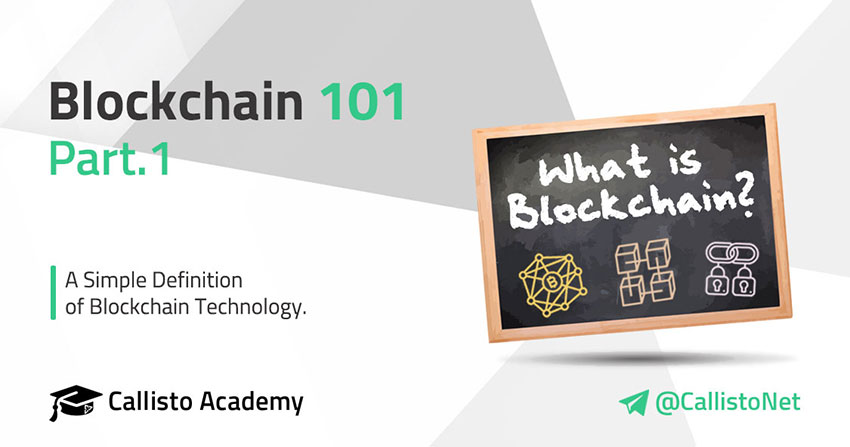Simple Definition of Blockchain
Blockchain is a system of recording information in a way that makes it difficult or impossible to change, hack, or cheat the system. A blockchain is essentially a digital ledger of transactions that is duplicated and distributed across the entire network of computer systems.
Our series of guides will walk you through what Blockchain is, how it’s used and its history.
Note: We do not intend to be exhaustive but rather simplify the topics covered to make them understandable to the largest number of people.

BLOCKCHAIN IS SIMPLY DEFINED AS A DECENTRALIZED, DISTRIBUTED LEDGER TECHNOLOGY THAT RECORDS THE HISTORY OF A DIGITAL ASSET.
What is Blockchain?
Blockchain technology is a structure that stores transactional records, also known as the block, of the users in several databases, known as the “chain,” in a network connected through peer-to-peer nodes. Typically, this storage is referred to as a ‘digital ledger.’
Every transaction in this ledger is authorized by the digital signature of the owner, which authenticates the transaction and safeguards it from tampering. Hence, the information the digital ledger contains is highly secure.
A simple analogy for understanding blockchain technology is a Google Doc. When we create a document and share it with a group of people, the document is distributed instead of copied or transferred. This creates a decentralized distribution chain that gives everyone access to the document at the same time. No one is locked out awaiting changes from another party, while all modifications to the doc are being recorded in real-time, making changes completely transparent.
Of course, blockchain is more complicated than a Google Doc, but the analogy is to the point because it illustrates four critical ideas of the technology:
- A blockchain is a database that stores information in blocks and then links them together to form a single source of chronological truth.
- This database is distributed instead of being copied or transferred, which guarantees an immutable record.
- A transparent record of transfers preserves the document’s integrity, thus creating confidence in the asset.
- Asset storage is decentralized, ensuring real-time access and full transparency to everyone.
How Does Blockchain Work?
Blockchain is an especially promising and revolutionary technology because it helps reduce risk, stamps out fraud and brings transparency in a scalable way for unlimited uses.
The whole point of using a blockchain is to let people — in particular, people who don’t trust one another — share valuable data in a secure, tamperproof way. -MIT Technology Review
The Blockchain consists of three important concepts: blocks, nodes and miners.
Blocks
Every chain consists of multiple blocks and each block has three basic elements:
- The data in the block.
- A 32-bit number called a nonce. The nonce is randomly generated when a block is created, which then generates the block hash.
- The hash is a 256-bit number associated with the nonce. It must start with a huge number of zeroes (i.e., be extremely small).
When the first block of a chain is created, a nonce generates the cryptographic hash. The data in the block is considered signed and forever linked to the nonce and hash unless it is mined.
Miners
Miners create new blocks on the chain through a process called mining. In a blockchain every block has its own unique nonce and hash, but also references the hash of the previous block in the chain, so mining a block isn’t easy, especially on large chains.
Miners use special software to solve the incredibly complex math problem of finding a nonce that generates an accepted hash. Because the nonce is only 32 bits and the hash is 256, there are roughly four billion possible combinations that must be mined before the right one is found. When that happens miners are said to have found the “golden nonce” and their block is added to the chain.
Making a change to any block earlier in the chain requires re-mining not just the block with the change, but all of the blocks that come after. This is why it’s extremely difficult to manipulate blockchain technology. Think of it is as “safety in math” since finding golden nonces requires an enormous amount of time and computing power.
When a block is successfully mined, the change is accepted by all of the nodes on the network and the miner is rewarded by receiving coins.
Nodes
One of the most important concepts in blockchain technology is decentralization. No single computer or organization can own the chain. Instead, it is distributed via the nodes. Nodes can be any kind of electronic device that maintains copies of the blockchain and keeps the network functioning.
Every node has its own copy of the blockchain and the network must algorithmically approve any newly mined block for the chain to be updated, trusted and verified. Since blockchains are transparent, every action in the ledger can be easily checked and viewed. Each participant is given a unique address (i.e. an alphanumeric identification number) that shows their transactions.
Combining public information with a system of checks-and-balances helps the blockchain maintain integrity and creates trust among users. Essentially, blockchains can be thought of as the scalability of trust via technology.
Article written by Gary J, an active member of the Callisto community.
Miscellaneous
Unveiling the Callisto Enterprise Token.
A Dynamic Motivation System for Callisto Network.
Cold Staking, Passive Income With Cryptocurrency For Everyone.
Follow us on Twitter to get our latest news and updates!

